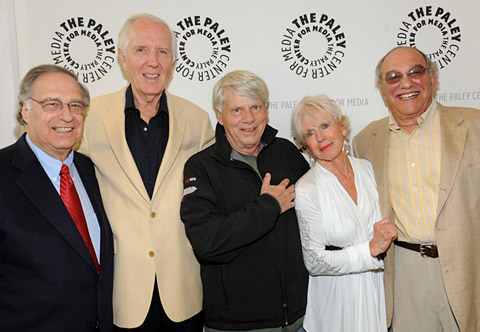

  |
|
|
||||||||||||||||||||||
|
FMS FEATURE... June 21, 2010 That's Life in the Annals of TV History Robert Morse's star-studded 1968 musical sitcom was ahead of its time by Jon Burlingame  Robert Morse poses next to a 1968 cover of TV Guide featuring himself and That's Life co-star E.J. Peaker. That's Life, which lasted just one season on ABC in 1968-69, was a daring attempt to create a Broadway-style musical comedy every week while also combining elements of situation comedy and the variety-show format. Morse and Peaker (who was simultaneously in production for her role as Minnie Fay in the film version of Hello, Dolly!) starred as a young couple who met, fell in love, married and had a baby over the course of 26 episodes. Fans were treated to the opening sequence of the first episode, which introduced the characters played by Morse and Peaker, along with guest star George Burns; and the entire second episode – complete with commercials for Kent cigarettes and Pontiac cars – in which happy-go-lucky bachelor Morse decides to propose to his immensely likable coworker Peaker. Guests in the second episode included singer Nancy Wilson and comedians Tim Conway and Jackie Vernon. It was a special treat because That's Life has apparently never been seen since its cancellation in spring 1969. The recent success of the weekly musical Glee – which has inevitably sparked discussion about such musical-series failures as Hull High, Cop Rock and Viva Laughlin – has only heightened the curiosity of fans about this ambitious but seemingly lost 1960s classic. "There was nothing like it at the time," recalled Morse (a Tony winner for both the play Tru and the musical How to Succeed in Business Without Really Trying, and currently starring on the AMC TV series Mad Men). "We wanted it to look like Broadway, not like television," added producer-director Stan Harris. "It's timeless," said Peaker. The show was staged before a studio audience (the first three episodes, in Hollywood; the rest in New York) and shot on videotape with four cameras. All of the singing was done live, with a 20-to-24 piece orchestra also playing live in a nearby studio. (As producer Lee Miller pointed out, the balance between voices and music was easier to achieve this way.) Among the collaborators, the panelists said, were creator Marvin Marx, who had been doing Honeymooners musicals with Jackie Gleason in Miami earlier in the 1960s; composer Elliot Lawrence (a Broadway veteran who had worked with Morse on How to Succeed in Business) and lyricist Martin Charnin (a later Tony winner for Annie); choreographer Tony Mordente (who had performed in West Side Story and would go on to direct many TV shows); and set designer Robert Randolph (whose Broadway credits included Bye Bye Birdie and How to Succeed...). Peaker said the show was sold without a pilot. Morse recalled a young Marvin Hamlisch working as a rehearsal pianist on the show and begging to write songs for it, which didn't happen ("he's never spoken to me since," quipped Morse). Each episode, writer Bob Ellison said, featured six songs, including three originals and three pre-existing tunes (often standards, such as the Gershwins' "Love Is Here to Stay," which Peaker sang in episode 2). All marveled at the list of top-name guest stars who appeared on the show, including Sid Caesar, Ethel Merman, Mahalia Jackson, Louis Armstrong, Alan King, Goldie Hawn, Liza Minnelli, Dick Shawn, Shelley Winters and even the Muppets. Reminiscing about Paul Lynde's appearance, Morse broke up the entire panel; Peaker regaled the crowd with anecdotes about guest star Chita Rivera and lunching with Shelley Berman at the famous Broadway hangout Sardi's.  (Left to right) That's Life producer Lee Miller, writer Bob Ellison, stars Robert Morse and E.J. Peaker, and producer-director Stan Harris. But, Miller added, the entire production process was much simpler in 1968. "There was no interference from the network," he said, and song negotiations were fairly easy. "It was rare that anybody objected to our use of music," he said. Music rights in that pre-DVD era, however, would not cover use for a release today, and the costs of clearing the dozens of tunes used on That's Life may mean the series will never be available commercially. "Everybody in show business was rooting for the show," noted Ellison. But despite critical acclaim, the series – which aired Tuesday nights at 10 p.m. Eastern, opposite a movie on NBC and news programming (including a new magazine show called 60 Minutes) on CBS – was mired in 82nd place by March 1969 and cancelled by ABC. As the Chicago Tribune wrote at the time, "maybe it's ahead of its time, and in 15 years will be considered a classic." Rene Reyes, producer of public programs and festivals for the Paley Center, served as host and moderator for the two-and-a-half-hour event. ©2010 Jon Burlingame |
Search
Past Features
Feature Archives
|